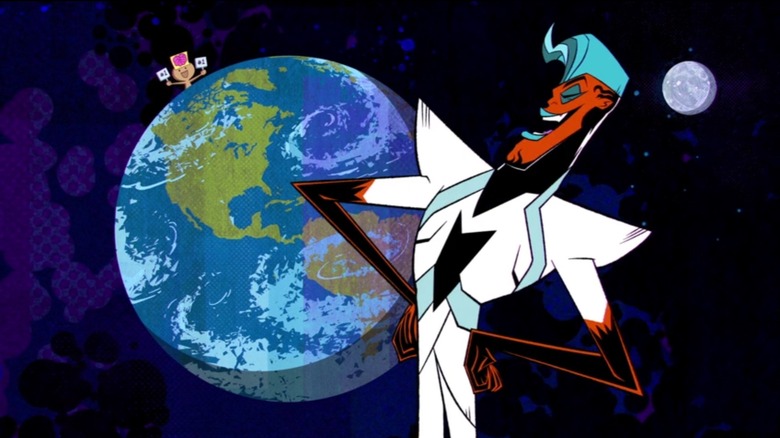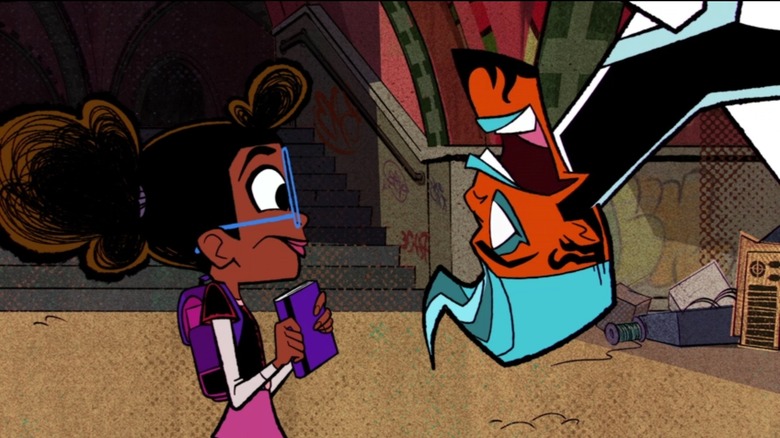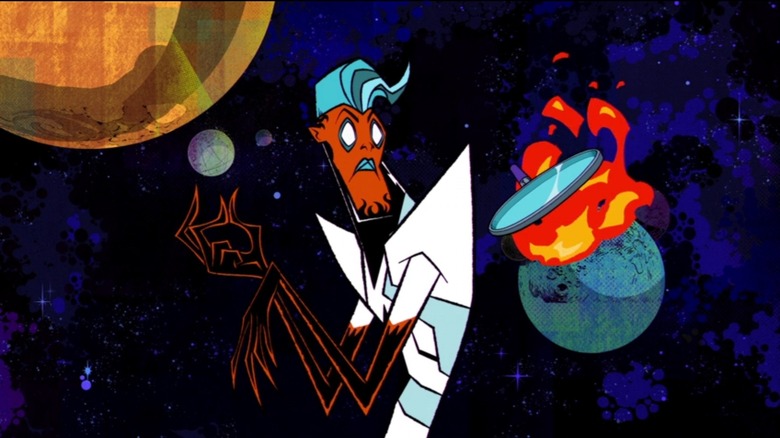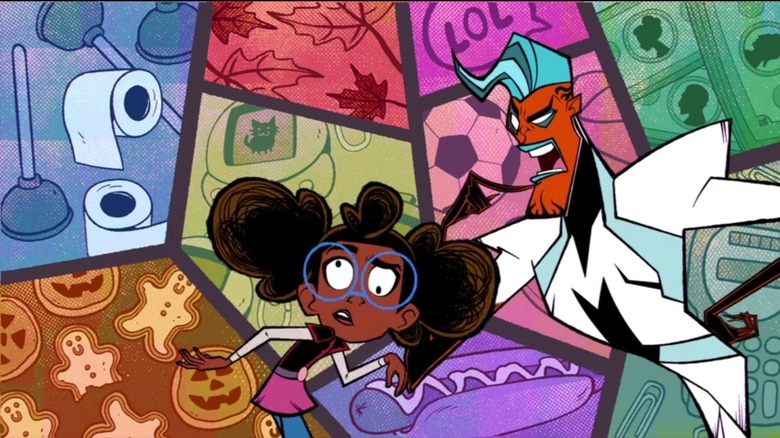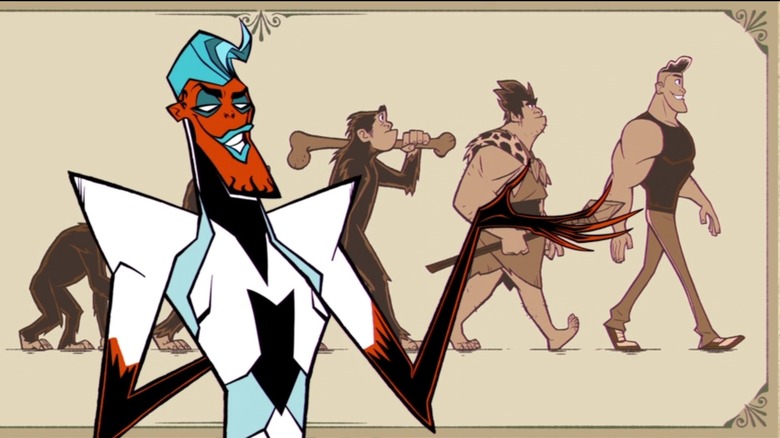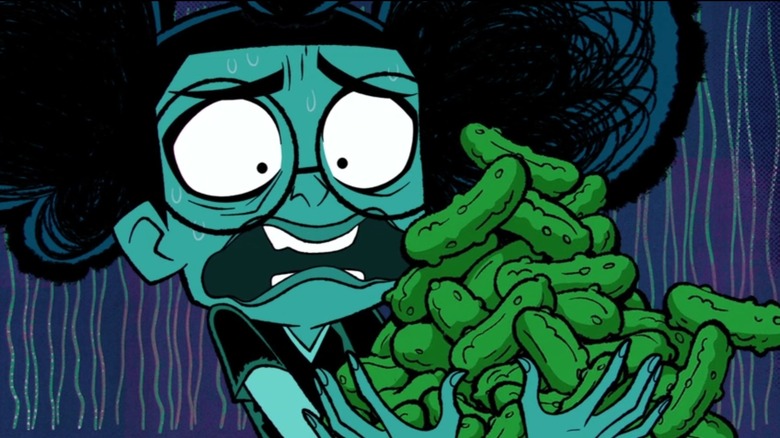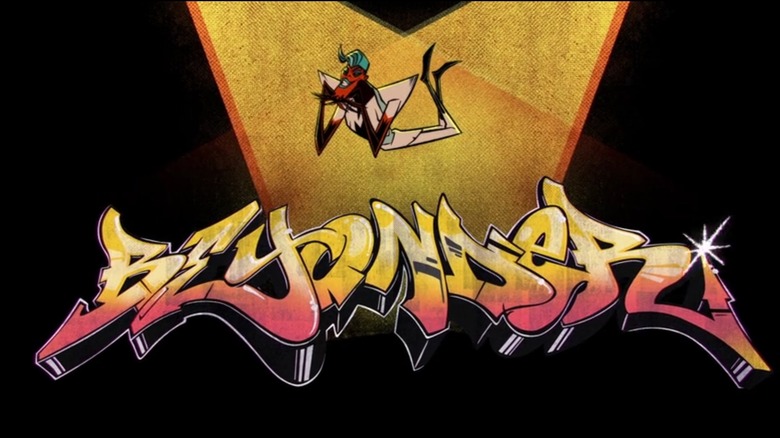Moon Girl And Devil Dinosaur Introduces Marvel's Most Annoying Villain To The Cinematic Universe
Early previews for "Moon Girl and Devil Dinosaur" teased the introduction of a classic villain to the Marvel Cinematic Universe: the Beyonder, an all-powerful being able to warp space and time with a thought. As played by Laurence Fishburne, the Beyonder performs musical numbers, changes shape, and threatens to end the universe for kicks. It's a quirky introduction to a character some have theorized might be the MCU's next big bad after Thanos, assuming Kang the Conqueror doesn't steal his thunder. Joe and Anthony Russo, the directors of "Avengers: Endgame," have said that "Secret Wars" is a favorite of theirs, and you can't have "Secret Wars" without The Beyonder.
There are smarter, crueler, and more dangerous foes in Marvel's archives than the Beyonder. Just look at Doctor Doom, who briefly usurped the Beyonder's power in the very first "Secret Wars." But the secret to the Beyonder's strength is that he is more annoying to deal with in the real world than he is in fiction. "Secret Wars" is more than just Spider-Man's black symbiote suit. It represents an era in Marvel's history that so aggravated its writers and artists that they rose in revolt against their editor-in-chief. It also led to a storyline in which Spider-Man taught the Beyonder how to pee.
But first, Jim Shooter
In order to understand the Beyonder and "Secret Wars," we have to talk about Jim Shooter. Shooter began writing superhero comics for DC when he was fourteen years old, then jumped ship to Marvel. Unable to pay his way in New York City, he burned out. He then managed a Kentucky Fried Chicken for a year per Sean Howe's "Marvel Comics: The Untold Story." In 1975, editor Marv Wolfman brought him back to serve as "pre-proofreader," editing scripts before they were sent to artists as part of the famous Marvel Method. Shooter rapidly rose through the ranks until he became editor-in-chief in 1978. He did so despite alienating legendary writers like Steve Engelhart and Steve Gerber, whose work he thought (per Howe) was "complicated and convoluted and didn't make any sense and wasn't written in English."
Shooter oversaw some of the best comics runs in Marvel's history during his tenure, including Frank Miller's "Daredevil," Walt Simonson's "Thor" and Chris Claremont's various "X-Men" titles (particularly those with artist John Byrne.) But Shooter constantly frustrated these writers and artists by meddling with their work. It was Shooter's idea that Jean Grey of the X-Men die as punishment for committing planetary genocide as the Phoenix. It was also Shooter's idea (together with David Michelinie and George Perez) to have a time traveler brainwash Captain Marvel and impregnate her with himself. The time traveler quickly grows to adult size after being born and takes Captain Marvel along with him. Iron Man responds, "we've just got to believe that everything worked out for the best." Contemporary readers were disgusted.
Secret Wars
Jim Shooter is best known today for 1984's "Secret Wars," a twelve-issue epic starring Marvel's most popular heroes and villains. Captain America, Doctor Octopus, several X-Men, and even Galactus all participate. "In essence," Shooter said (per Howe) "I was fulfilling the destiny of the Marvel Universe from its inception." In reality, "Secret Wars" was made because (again, per Howe) market researchers found that "secret" and "wars" were "two words that made kids go wild." It was meant to promote an upcoming Mattel toy line starring the heroes and villains featured in the comic. The series has its charms, like a unique take on the villain Molecule Man and the introduction of super-strong villainess Titania. But it was unmistakably a mercenary production, and far too long to boot. "It's simplistic, it's obnoxious and it's boring," says Jay Edidin in episode 43 of the podcast "Jay and Miles X-Plain the X-Men."
The villain of "Secret Wars" is the Beyonder, who transports the heroes and villains of Marvel to a mixed-up planetoid called Battleworld. "Slay your enemies," he says, "and all that you desire shall be yours! Nothing you dream of is impossible for me to accomplish!" He proceeds to slap down Galactus, who immediately called his bluff. Other than his great power and booming voice, the reader learns surprisingly little about the Beyonder in "Secret Wars." As you'd expect from a comic designed to sell toys, he's a cosmic excuse for heroes and villains to battle it out rather than an actual character. Fans would have to wait until 1985's "Secret Wars II" to understand his motivations.
Secret Wars II
"Secret Wars II" had neither secrets nor wars. Instead, it is the story of a god, the Beyonder, who longs to understand humanity. After visiting his friend Molecule Man, he travels the world of Marvel and learns about food, money, and sex. A mobster named Vinny teaches him how to put on pants. Eventually, the Beyonder takes over the world but is dissuaded by a woman named Circuit Breaker looped in from Marvel's ongoing "Transformers" comics. The most infamous scene in the series comes earlier when Spider-Man offers the Beyonder a drink of water. The Beyonder asks if it will "relieve this strange pressure—this fullness I feel in my lower abdomen?" In response, Spider-Man points him towards the bathroom. Upon finishing his task, the Beyonder cries, "the experience is consummated!" He then vanishes in a flash of light to go bother Reed Richards.
In Shooter's defense, "Secret Wars II" was meant to be ridiculous. While the original "Secret Wars" was pure capitalist product, "Secret Wars II" critiqued the excesses of the Reaganite 1980s. The Beyonder mirrors the hunger of the people around him. He changes his clothes, transforms buildings into gold and makes the population of Earth worship and obey him. But true happiness lies just out of reach. Despite its ambitions, "Secret Wars II" was let down once more by glacial pacing and bad writing. Sean Howe called it "an endless shaggy dog tale." Jay Edidin went even further, blasting it as "the twisted reflection of everything that is wrong with shared universe superhero comics in the mid-1980s."
Behind the wars
"Secret Wars II" was a disappointment to readers, but its true legacy is the inconvenience it caused Marvel's writers and artists. The series supplemented its nine core issues with over thirty tie-ins with series like "The Amazing Spider-Man," "Avengers" and "New Mutants." Their creators were asked to put their plans on hold and play nice with their editor-in-chief. Had Shooter embodied the efficiency he demanded of his staff, this might have been doable. But this was not the case. Shooter repeatedly failed to communicate what he wanted to his collaborators, and then refused to compromise when their work failed to meet his expectations. Sean Howe quotes Marvel writer Peter Gillis as saying, "every crossover got redone about three times because Jim just didn't like it."
Over the next two years, Shooter became increasingly demanding and out of touch. His storytelling edicts, such as "having everyone state their motivations in every issue" per Jay Edidin, already cluttered "Secret Wars" and "Secret Wars II." Shooter kept adding new rules and lashing out at writers and artists he believed flaunted those rules on purpose. Per Sean Howe, editor Terry Kavanagh remembers Shooter shouting in the face of writer Ann Nocenti. "I would've been scared if I were her," Kavanagh said. Nocenti wasn't the only writer to suffer under Shooter's leadership. Chris Claremont struggled to maintain creative control of "X-Men." John Byrne left for DC. In late 1986, following widespread lack of faith in Marvel's new owners New World Pictures, frustrated staff stormed Shooter's office. Shooter left Marvel in mid-April the next year, a victim of unpopularity and his own obsessive micromanagement.
After the wars
A few comics fans have reassessed Jim Shooter's legacy in recent years. Shelfdust's "The War Effort," a podcast featuring critics like the aforementioned Jay Edidin, is surprisingly kind to the original "Secret Wars" even as it has fun at the comic's expense. Claire Napier singles out the relationship between Molecule Man and Volcana as a highlight. Elsewhere, manga translator Zack Davisson tweeted that Jim Shooter's belief that "every comic is someone's first comic" once ensured superhero comics remained accessible to a broader audience. Revoking this rule satisfied artists in the short term but made comics inaccessible in the long term. Of course, Shooter's many tie-ins for "Secret Wars II" also paved the road towards that inaccessibility. Future comic events would become even more unwieldy from that point forward.
The Beyonder is Shooter's signature creation, and thus carries baggage. First introduced as the architect of a marketing push, the character was repurposed to critique those capitalist impulses. The Beyonder didn't just make life difficult for hardworking Marvel heroes like Spider-Man. He complicated the lives of real writers and artists at the company, who worked late nights to satisfy the demands of their indecisive editor-in-chief. These writers and artists believed themselves to be the victim of a terrible boss. But Shooter always sympathized with bosses. Howe's "Marvel Comics: The Untold Story" remembers Jim Shooter's "Korvac Saga," published in 1978. Its tale of a misunderstood immortal struggling to build utopia preceded "Secret Wars II." "Where others saw megalomania," Howe says, "Shooter saw a beleaguered hero who only wanted to bring order to the galaxy."
The new Beyonder
The Beyonder is more than an all-powerful substitute for Thanos or Kang the Conqueror. He is a tragic figure, and also an annoying one. Grappling with the nature of life and happiness in the 1980s comes as naturally to him as asking Spider-Man why his bowels feel funny. With that in mind, his portrayal in "Moon Girl and Devil Dinosaur" is just about perfect. First of all, he's voiced by the producer of the series Laurence Fishburne, which is a great meta-joke. He controls real-life, Disney-adjacent celebrities like Selena Gomez, further bridging the gap between reality and fiction. Best of all, "Moon Girl and Devil Dinosaur" is an animated series, and is thus better suited than either comics or live-action to conveying the Beyonder's personality. The Beyonder's design warps and abstracts as his feelings shift, setting him apart from the inhabitants of Moon Girl's Lower East Side. The world around him also changes as he does, breaking visual rules established by earlier episodes. He's a credible threat to the young adult world of "Moon Girl and Devil Dinosaur," which operates on a smaller scale than the rest of the Marvel Cinematic Universe.
There's no reason why a teenager like Lunella Lafayette ought to deal with a godlike entity like the Beyonder. That's a job for the Avengers, not just Moon Girl. But then, that's what makes the Beyonder tick. He's not just an apocalyptic entity able to erase everything Lunella's ever loved with the snap of a finger. He's an inconvenience. Jim Shooter may have created the Beyonder, but only "Moon Girl and Devil Dinosaur" could do him justice.
